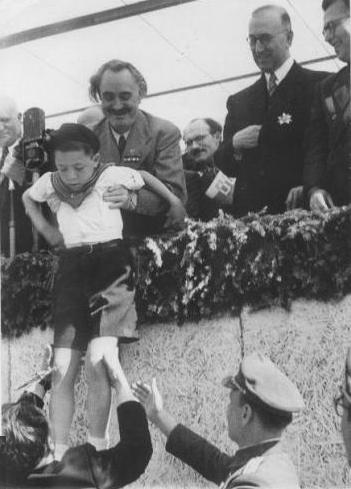
Cold War Bulgaria: People's Republic (1946)

Figure 1.-- Here Bulgarian Communist leader Georgi Dimitrov passs a Pioneer boy down from the podium at a Communist May Day celebration (1947). After years of struggle and exile, as a cloe ally of stalin he was finally in power. He look like a fatherfigure, but the DS secret police had made thousands of arrests and executions. some 100,000 people were in his labor camps where mny would perish. Generally seen as Stalin's Bulgarian 'lap dog' 2 years after this photograph was taken, he would die unexpectely at a Moscow sanitorium. It is widely belieced that Stalin ordered the NKVD to poison him, sespecting disloyalty. | |
The Bulgarian Worker's Party (BWP) proceeded to proclaime the People's Republic. The BWP the world war II name of the Coominist Party and was led by Georgi Dimitrov, a long-term Communist with an unternational reputation. (A leading Agrarian Party leader had the same name.) Dimitrov because of his close association with stalin became Bulgaria's first communist leader (1946-49). Stalin chose Dimitrov for some reason, we are not entirely sure why, to be his front man to lead the Third Comintern (Communist International) (1934-1943). Having a non-Eurasian to lead it provide some window-dressing to disguise Stalin's absolute control of the Comintern. Dimitrov was a Marxist theorist focusing on capitalism. He expanded Lenin's views by arguing that Fascism was the dictatorship of the most reactionary elements of 'financial capitalism'. In fact nothing could be further from the truth. Fascism like Communism involved seizing control of the economy. Under Fascism, business were left nonimally in private hands, but control was in the hands of party leaders. Only with liberal democracies was meaningful private ownrship possible and real competition. Dimitrov as a young man trained as a compositor and became active in the Sofia labor movement. He became active in the Bulgarian socialist movement which affiliated with Bolshevism and the Comintern. He achieved considerable prestige in the socialist community for opposition to World War I (1917), involvement in a coup (1923), and than his trial in Berlin, charged by the NAZIs with involvement in the Reichstag Fire (1933). His support for Stalin was noted and rewarded. As the Red Army drove toward the Balkans adter the German defeat at Kurksk (1943), Dimitrov resigned his Comintern post and began focusing on Bulgarian politics. And with the Red Army supporting him, began to establish the foundation for a Communist Bulgaria (1944). The Fatherland Front presented a unified list of candidates (November 1945). They received 3.0 million votes. The opposition garnered 1.2 million vote. The Fatherland Front was of course a thinly veiled front for the Communists. The election gave the Communists and Dimitrov control of the new National Assembly. A referendum was held on the monarchy (September 1946). The result was the abolition of the monarchy and the royal family was exiled. The Communists moved to consolidated their hold on Bulgaria. Elections for a constituent assembly gave the Communist Party a majority (October 1946). The next month Dimitrov became prime minister. The constituent assembly ratified a new constitution -- the "Dimitrov Constitution" (December 1947). The drafting of the constitution was overseen by 'fraternal' Soviet jurists who of couse raised the 1936 Soviet Constitution as an ideal model. It declared Bulgaria to be a People's Republic. Dimitrov et up up the mot Stalinist ofall the Eastern European Stalinist regimes. The Bulgarian secret police which the NKVD helped estanlish was State Security (DS) and proved highly efficent. The remaining opposition parties were either realigned or dissolved. Any real opponents were arrested. The Social Democrats merged with the Communists, while the Agrarian Union became a loyal Communist partner. Dimitrov as expected adopted orthodox Stalinist policies. He oversaw the collectivization of agriculture. He also began an industrialisation campaign. And along with hese new efforts a widespred program of repression was iniitiated. Opponents, ‘class traitors’, and a range of 'awkward' individuals were harshly dealt with. by the strict Stalinist regime, Peasant resistance was crushed as Stalin had done. Labor camps were set up and would eventually reach a level of 100,000 detainees. Thousands were executed, at first the disidents but as in the Soviet Union Communist Party members soon folloed. Many more died in the labor camps. [Sharlanov and Ganev] The Communists under Dimitrov launched an atheism campaign. The DS confined th Orthodox Patriarch to a monastery and the his Church placed under Communist control.
Sources
CIH

Navigate the Children in History Website:
[Return to Main Bulgarian Cold War history page]
[Return to Main Bulgarian history page]
[Return to Main Cold War European country page]
[Return to Main Cold War country page]
[Return to Main Communism page]
[Return to Main Bulgarian page]
[About Us]
[Introduction][Animals][Biographies][Chronology][Climatology][Clothing][Disease and Health][Economics][Ethnicity][Geography][History][Human Nature][Law]
[Nationalism][Presidents][Religion][Royalty][Science][Social Class]
[Bibliographies][Contributions][FAQs][Glossaries][Images][Links][Registration][Tools]
[Children in History Home]
Created: 5:48 PM 12/16/2015
Last updated: 5:48 PM 12/16/2015



